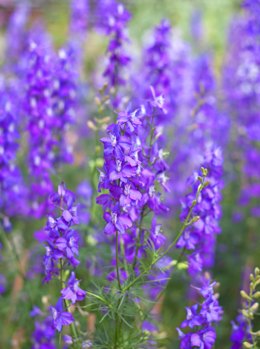Hyssop is a plant of the mint family, and is widely found in the Central Asia and Mediterranean regions. The plant, especially its leaves and flowers are used for flavoring a number of dishes, and to prepare a traditional medicine for respiratory ailments.

Hyssop or
Hyssopus is a genus of herbaceous and semi-woody plants, that includes about 10 to 12 species, which are native to the Mediterranean regions and Central Asia. The plants of the genus
Hyssopus belong to the family,
Lamiaceae or the mint family. The term hyssop is generally used for the plant,
Hyssopus officinalis, which is the most widely recognized species of hyssop.
Hyssop is known for its aromatic leaves and flowers, which are not only used as a flavoring agent in food and beverages, but are known to have a history of being used in the traditional medicine for relieving cough. The leaves of this plant are generally used to prepare tea that is used along with honey to alleviate respiratory problems and cough. The medicinal properties of the plant can be mainly attributed to the presence of highly aromatic and volatile oil in its leaves, stems, and flowers.
Plant Description
Hyssop or
Hyssopus officinalis is a perennial garden herb with erect and slender, semi-woody stem, that can grow up to a height of about 60 cm. The leaves are small and narrow, and are oblong in shape. They can reach a length of about 2 to 5 cm, and are found to be arranged oppositely on the stem. The plant produces flowers from July to October, i.e., from summer to fall. The flowers appear in a small cluster or whorl, set along the upper portion of the stem.
The blossoms are usually purple-blue, red, white, or light pink in color. The flowers can attract a large number of bees, butterflies, and hoverflies due to their strong scent. Hyssop is generally grown as a border plant in a herb garden. The plant can attract white butterflies, and thus keep them away from cabbage. So, it can help control the damage caused by the white butterfly caterpillars to cruciferous crops like cabbage. This is the reason why hyssop is considered an ideal companion plant for cabbage..
How to Grow Hyssop
Hyssops can be included in both herb and flower gardens, basically as border plants. They can make excellent edging plants for any garden. More commonly, the hyssop plant is grown from the seeds, which can be sown in the spring. However, cuttings as well as root divisions can also be used for propagating the plant. For growing hyssop, choose a site that receives a lot of sunlight. The soil should be warm and well-drained for growing this plant.
The seeds will take about two to three weeks to germinate from the time of sowing. The seedlings should be planted 40 to 50 cm apart, and about quarter of an inch deep into the soil. Hyssop can also be grown in pots or containers. For this, you will need a large container of about 11 to 12 inches, as this plant develops a large and extensive root system. You can prune the plant at regular intervals to give it a bushy look. At the end of the blooming season, when the seeds capsules have dried completely, you can collect the seeds to grow new plants.
The aromatic oil found in the leaves, stems, and the flowers of this plant is used as an ingredient in liquors, like Benedictine and Chartreuse. You can also use the leaves and seeds (in small amounts) in chicken soups, sauces, and meat and vegetable dishes. The fresh or dried flowers can be used to decorate your home as well. To sum up, this small and pretty plant can be a great addition to a herb or flower garden. It will surely attract butterflies and bees to your garden, and thus help encourage pollination and control pests naturally.






 Hyssop or Hyssopus is a genus of herbaceous and semi-woody plants, that includes about 10 to 12 species, which are native to the Mediterranean regions and Central Asia. The plants of the genus Hyssopus belong to the family, Lamiaceae or the mint family. The term hyssop is generally used for the plant, Hyssopus officinalis, which is the most widely recognized species of hyssop.
Hyssop or Hyssopus is a genus of herbaceous and semi-woody plants, that includes about 10 to 12 species, which are native to the Mediterranean regions and Central Asia. The plants of the genus Hyssopus belong to the family, Lamiaceae or the mint family. The term hyssop is generally used for the plant, Hyssopus officinalis, which is the most widely recognized species of hyssop.